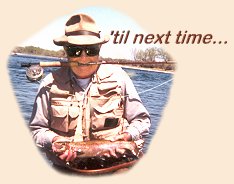
| ||
|
June 14th, 2004
|
|
Q. I read your article about the various types of macroinvertabrates found in a trout stream. I attended a conservation camp over the summer and from what I remember we were taught that the various types of shredders, grazers, etc. were to be found at different gradients in the stream. This does not make sense to me because it would seem that if there were leaves falling in one area, then the type of insect that could utilize this food source would be present in that area, regardless of the gradient. Is this correct?
A.
You're absolutely correct, gradient has nothing to
do with the type of functional groups present; it
is related to the available food resources. Having
said this, there is a related factor that your
instructors may have mixed in. This is the fact
that most CPOM, and thus shredders, are usually
found in the small headwater reaches of streams
which also happens to be the region where gradients
are usually higher. At the same time, grazers are
most abundant where adequate sunlight reaches the
stream bed so that algae can grow, and this usually
occurs in the mid-reaches of streams where the gradient
is usually less than in the headwaters. This is
coincidence; gradient is not the determining
factor - the food resources are. All of this
emphasizes the fact that the insect communities
found at a certain location in a stream are the
result of many interacting factors; thus, care
should be taken when attributing something to any
one factor.
~ C. E. (Bert) Cushing, aka Streamdoctor 105 W. Cherokee Dr. Estes Park, CO 80517 Phone: 970-577-1584 Email: streamdoctor@aol.com
|
| If you would like to comment on this or any other article please feel free to post your views on the FAOL Bulletin Board! |
 The 'Stream Doctor' is a retired professional stream ecologist and
author, now living in the West and spending way too much time
fly-fishing. You are invited to submit questions relating to
anything stream related directly to him for use in this Q & A Feature
at
The 'Stream Doctor' is a retired professional stream ecologist and
author, now living in the West and spending way too much time
fly-fishing. You are invited to submit questions relating to
anything stream related directly to him for use in this Q & A Feature
at